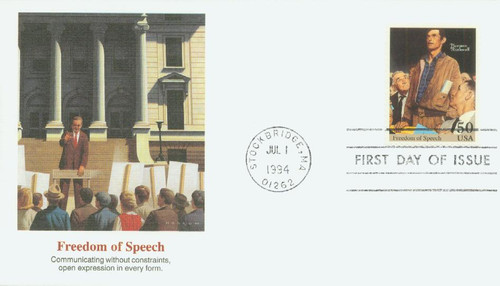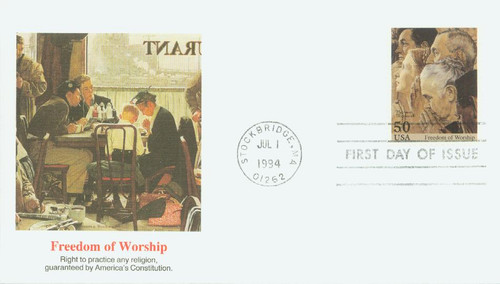
1994 50c Rockwell Freedom of Speech
# 2840c - 1994 50c Rockwell Freedom of Speech
$1.75 - $2.95
U.S. #2840
50¢ Norman Rockwell
50¢ Norman Rockwell
Issue Date: July 1, 1994
City: Stockbridge, MA
Quantity: 20,000,000
Printed By: Ashton Potter
Printing Method: Lithographed
Perforations: 10.9 x 11.1
Color: Multicolored
City: Stockbridge, MA
Quantity: 20,000,000
Printed By: Ashton Potter
Printing Method: Lithographed
Perforations: 10.9 x 11.1
Color: Multicolored
On January 6, 1941, as World War II raged in Europe, President Franklin Delano Roosevelt addressed Congress. He submitted that any settlement reached after the war should be based upon "four freedoms": freedom of speech, freedom of worship, freedom from want, and freedom from fear. Norman Rockwell created four paintings, each titled after one of the freedoms, that visually idealize the concepts of Roosevelt's speech. More than one million people saw the paintings on a 16-city tour to promote war-bonds. The tour was a tremendous success, and over $130 million was raised for the cause.
Norman Rockwell
By the 1930s Rockwell was doing covers for the Post almost exclusively. In 1930 he met and married Mary Barstow Rhodes. They had three sons, and interestingly, many of his Post covers from this period reflect the change in his point of view - from observer to participant. By the end of the ’30s he had produced the mature style for which he is best remembered.
Honored by the Art Director’s Club in 1940 for the best advertising poster of the year, Rockwell soon shifted his focus to World War II subjects. G.I. Willie Gillis and Rosie the Riveter were some of the characters who found expression in his work.
The years following the war were filled with social and intellectual changes, many of which are reflected in Rockwell’s work. During this time he produced some of his best-known covers. In 1963, the Post ended its 47-year relationship with him, however he continued to work for magazines such as McCall’s and Look. The last cover he painted was for American Artist in 1976. That same year the town of Stockbridge, Massachusetts held a parade in his honor. The longest parade in the town’s history, it lasted more than two hours. On November 8, 1978, Norman Rockwell died at his Stockbridge home at the age of 84.
Rockwell’s Four Freedoms
In 1942, Norman Rockwell began a series of four paintings that pictured ordinary Americans in scenes portraying the ideals for which the United States had gone to war. Called The Four Freedoms, the series included Freedom of Worship, Freedom of Speech, Freedom from Fear, and Freedom from Want.
Unlike much of his other work, these paintings were not designed as illustrations, but rather as original works of art. More than one million people saw the original paintings in a 16-city tour on behalf of war bonds. So successful was the tour that over $130 million was raised for the cause. Publishing the paintings as inside illustrations, The Saturday Evening Post generated an equally impressive response from its readers. Government agencies that had turned down the series when Rockwell offered it to them soon realized their error, for these powerful images struck a chord that reverberated around the country.
Despite a devastating studio fire in 1943 in which he lost many irreplaceable paintings and sketches, as well as his entire collection of books, antique costumes, and props, Rockwell continued his war effort. His most memorable covers from the war years include Rosie the Riveter, Home for Thanksgiving, and Homecoming G.I.
U.S. #2840
50¢ Norman Rockwell
50¢ Norman Rockwell
Issue Date: July 1, 1994
City: Stockbridge, MA
Quantity: 20,000,000
Printed By: Ashton Potter
Printing Method: Lithographed
Perforations: 10.9 x 11.1
Color: Multicolored
City: Stockbridge, MA
Quantity: 20,000,000
Printed By: Ashton Potter
Printing Method: Lithographed
Perforations: 10.9 x 11.1
Color: Multicolored
On January 6, 1941, as World War II raged in Europe, President Franklin Delano Roosevelt addressed Congress. He submitted that any settlement reached after the war should be based upon "four freedoms": freedom of speech, freedom of worship, freedom from want, and freedom from fear. Norman Rockwell created four paintings, each titled after one of the freedoms, that visually idealize the concepts of Roosevelt's speech. More than one million people saw the paintings on a 16-city tour to promote war-bonds. The tour was a tremendous success, and over $130 million was raised for the cause.
Norman Rockwell
By the 1930s Rockwell was doing covers for the Post almost exclusively. In 1930 he met and married Mary Barstow Rhodes. They had three sons, and interestingly, many of his Post covers from this period reflect the change in his point of view - from observer to participant. By the end of the ’30s he had produced the mature style for which he is best remembered.
Honored by the Art Director’s Club in 1940 for the best advertising poster of the year, Rockwell soon shifted his focus to World War II subjects. G.I. Willie Gillis and Rosie the Riveter were some of the characters who found expression in his work.
The years following the war were filled with social and intellectual changes, many of which are reflected in Rockwell’s work. During this time he produced some of his best-known covers. In 1963, the Post ended its 47-year relationship with him, however he continued to work for magazines such as McCall’s and Look. The last cover he painted was for American Artist in 1976. That same year the town of Stockbridge, Massachusetts held a parade in his honor. The longest parade in the town’s history, it lasted more than two hours. On November 8, 1978, Norman Rockwell died at his Stockbridge home at the age of 84.
Rockwell’s Four Freedoms
In 1942, Norman Rockwell began a series of four paintings that pictured ordinary Americans in scenes portraying the ideals for which the United States had gone to war. Called The Four Freedoms, the series included Freedom of Worship, Freedom of Speech, Freedom from Fear, and Freedom from Want.
Unlike much of his other work, these paintings were not designed as illustrations, but rather as original works of art. More than one million people saw the original paintings in a 16-city tour on behalf of war bonds. So successful was the tour that over $130 million was raised for the cause. Publishing the paintings as inside illustrations, The Saturday Evening Post generated an equally impressive response from its readers. Government agencies that had turned down the series when Rockwell offered it to them soon realized their error, for these powerful images struck a chord that reverberated around the country.
Despite a devastating studio fire in 1943 in which he lost many irreplaceable paintings and sketches, as well as his entire collection of books, antique costumes, and props, Rockwell continued his war effort. His most memorable covers from the war years include Rosie the Riveter, Home for Thanksgiving, and Homecoming G.I.









